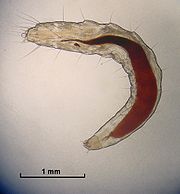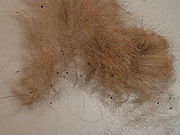
Cat flea
Encyclopedia
The cat flea, Ctenocephalides felis, is one of the most abundant and widespread species of flea
on Earth
.
s in most of the world. The cat flea can also maintain its life cycle
on other carnivore
s and on the Virginia opossum
. Human
s can be bitten, though a population of cat fleas cannot be sustained and infest people. However, if the female flea is allowed to feed for twelve consecutive hours, it can lay viable eggs.
 The eggs hatch into larva
The eggs hatch into larva
e, which are negatively phototaxic
, meaning that they hide from light in the substrate. Flea larvae feed on a variety of organic substances, but most importantly subsist on dried blood that is filtered out of the haircoat of the host after it is deposited there as adult flea fecal material. Thus the adult population on the host feeds the larval population in the host's environment. Flea larvae metamorphose through 4 stages before spinning a cocoon and entering the pupal stage
Flea larvae metamorphose through 4 stages before spinning a cocoon and entering the pupal stage
. The pupal stage varies greatly in length; the pre-emergent flea does not normally emerge as a young adult flea until the presence of a potential host is perceived by warmth or vibration. Newly emerged fleas are stimulated to jump to a new host within seconds of emerging from the cocoon. The new flea begins feeding on host blood within minutes.
. Small animals with large infestations can lose enough bodily fluid to fleas feeding that dehydration
may result. Fleas are also responsible for disease transmission through humans. If the fleas have been sucking blood, then they will have a reddish-brown colour when squashed.
Fleas are capable of surviving for up to 100 days.
and infections to dogs and cats and also to humans. The most prominent of these are Bartonella
, murine typhus
, and apedermatitis. The tapeworm Dipylidium caninum
can be transmitted when a flea is swallowed by pets or humans. In addition, cat fleas have been found to carry Borrelia burgdorferi
, the etiologic agent of Lyme disease
, but their ability to transmit the disease is unclear.
Flea
Flea is the common name for insects of the order Siphonaptera which are wingless insects with mouthparts adapted for piercing skin and sucking blood...
on Earth
Earth
Earth is the third planet from the Sun, and the densest and fifth-largest of the eight planets in the Solar System. It is also the largest of the Solar System's four terrestrial planets...
.
Overview
The cat flea's primary host is the domestic cat, but this is also the primary flea infesting dogDog
The domestic dog is a domesticated form of the gray wolf, a member of the Canidae family of the order Carnivora. The term is used for both feral and pet varieties. The dog may have been the first animal to be domesticated, and has been the most widely kept working, hunting, and companion animal in...
s in most of the world. The cat flea can also maintain its life cycle
Biological life cycle
A life cycle is a period involving all different generations of a species succeeding each other through means of reproduction, whether through asexual reproduction or sexual reproduction...
on other carnivore
Carnivore
A carnivore meaning 'meat eater' is an organism that derives its energy and nutrient requirements from a diet consisting mainly or exclusively of animal tissue, whether through predation or scavenging...
s and on the Virginia opossum
Virginia Opossum
The Virginia opossum , commonly known as the North American opossum or tlacuache in Mexico, is the only marsupial found in North America north of Mexico. A solitary and nocturnal animal about the size of a domestic cat, and thus the largest opossum, it is a successful opportunist...
. Human
Human
Humans are the only living species in the Homo genus...
s can be bitten, though a population of cat fleas cannot be sustained and infest people. However, if the female flea is allowed to feed for twelve consecutive hours, it can lay viable eggs.
Life cycle
The female cat flea lays her eggs on the host, but the eggs, once dry, have evolved to filter out of the haircoat of the host into the resting and sheltering area of the host.
Larva
A larva is a distinct juvenile form many animals undergo before metamorphosis into adults. Animals with indirect development such as insects, amphibians, or cnidarians typically have a larval phase of their life cycle...
e, which are negatively phototaxic
Phototaxis
Phototaxis is a kind of taxis, or locomotory movement, that occurs when a whole organism moves in response to the stimulus of light. This is advantageous for phototrophic organisms as they can orient themselves most efficiently to receive light for photosynthesis...
, meaning that they hide from light in the substrate. Flea larvae feed on a variety of organic substances, but most importantly subsist on dried blood that is filtered out of the haircoat of the host after it is deposited there as adult flea fecal material. Thus the adult population on the host feeds the larval population in the host's environment.

Pupa
A pupa is the life stage of some insects undergoing transformation. The pupal stage is found only in holometabolous insects, those that undergo a complete metamorphosis, going through four life stages; embryo, larva, pupa and imago...
. The pupal stage varies greatly in length; the pre-emergent flea does not normally emerge as a young adult flea until the presence of a potential host is perceived by warmth or vibration. Newly emerged fleas are stimulated to jump to a new host within seconds of emerging from the cocoon. The new flea begins feeding on host blood within minutes.
Effects on the hosts
A few fleas on adult dogs or cats cause little harm unless the host becomes allergic to substances in saliva. The disease that results is called flea allergy dermatitisFlea allergy dermatitis
Flea allergy dermatitis is an eczematous itchy skin disease of dogs and cats. For both of these domestic species flea allergy dermatitis is the most common cause of skin disease. Affected animals develop allergic reactions to chemicals in flea saliva...
. Small animals with large infestations can lose enough bodily fluid to fleas feeding that dehydration
Dehydration
In physiology and medicine, dehydration is defined as the excessive loss of body fluid. It is literally the removal of water from an object; however, in physiological terms, it entails a deficiency of fluid within an organism...
may result. Fleas are also responsible for disease transmission through humans. If the fleas have been sucking blood, then they will have a reddish-brown colour when squashed.
Fleas are capable of surviving for up to 100 days.
Disease transmission
Cat fleas can transmit other parasitesParasitism
Parasitism is a type of symbiotic relationship between organisms of different species where one organism, the parasite, benefits at the expense of the other, the host. Traditionally parasite referred to organisms with lifestages that needed more than one host . These are now called macroparasites...
and infections to dogs and cats and also to humans. The most prominent of these are Bartonella
Bartonella
Bartonella is a genus of Gram-negative bacteria. Facultative intracellular parasites, Bartonella species can infect healthy people but are considered especially important as opportunistic pathogens. Bartonella are transmitted by insect vectors such as ticks, fleas, sand flies and mosquitoes...
, murine typhus
Murine typhus
Murine typhus is a form of typhus transmitted by fleas , usually on rats. Murine typhus is an under-recognized entity, as it is often confused with viral illnesses...
, and apedermatitis. The tapeworm Dipylidium caninum
Dipylidium caninum
Dipylidium caninum, also called the cucumber tapeworm or the double-pore tapeworm, is a cyclophyllid cestode that infects organisms afflicted with fleas, including canids, felids, and pet-owners, especially children. Adult worms are about 18 inches long...
can be transmitted when a flea is swallowed by pets or humans. In addition, cat fleas have been found to carry Borrelia burgdorferi
Borrelia burgdorferi
Borrelia burgdorferi is a species of Gram negative bacteria of the spirochete class of the genus Borrelia. B. burgdorferi is predominant in North America, but also exists in Europe, and is the agent of Lyme disease....
, the etiologic agent of Lyme disease
Lyme disease
Lyme disease, or Lyme borreliosis, is an emerging infectious disease caused by at least three species of bacteria belonging to the genus Borrelia. Borrelia burgdorferi sensu stricto is the main cause of Lyme disease in the United States, whereas Borrelia afzelii and Borrelia garinii cause most...
, but their ability to transmit the disease is unclear.
External links
- Integrated Flea Control from University of Nebraska-Lincoln Extension in Lancaster County
- cat flea on the UFUniversity of FloridaThe University of Florida is an American public land-grant, sea-grant, and space-grant research university located on a campus in Gainesville, Florida. The university traces its historical origins to 1853, and has operated continuously on its present Gainesville campus since September 1906...
/ IFASInstitute of Food and Agricultural SciencesThe University of Florida’s Institute of Food and Agricultural Sciences is a federal-state-county partnership dedicated to developing knowledge in agriculture, human and natural resources, and the life sciences, and enhancing and sustaining the quality of human life by making that information...
Featured Creatures Web site - About Ctenocephalides felis (cat flea): taxonomy, life cycle, transmitted diseases, eradication at MetaPathogen
Flea treatment
- How to Rid Your Pet of Fleas from Wikihow
- Finding and Eliminating Fleas on Your Cat from the BBC
- Safe Use of Flea and Tick Products in Pets

